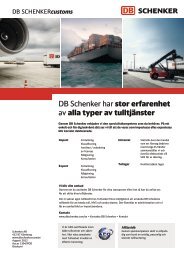PDF Download - Schenker
PDF Download - Schenker
PDF Download - Schenker
Create successful ePaper yourself
Turn your PDF publications into a flip-book with our unique Google optimized e-Paper software.
GRI<br />
LA9<br />
TRAINING AND EDUCATION<br />
LA9. Training and education<br />
The extent of training and education during the year remained largely on the<br />
same level as 2009. In total, 875 employees took part in one of the DB <strong>Schenker</strong><br />
centrally administered training programmes. Skills development can also be<br />
regarded as including other forms of training, both external arrangements and<br />
locally arranged courses. This information is not available on a central level<br />
and is not reported here.<br />
From the central training statistics, we note that female course participation,<br />
both in operational training and management/leadership training, increased<br />
significantly compared with the previous year. Almost half (47%) of the participants<br />
in the leadership training programmes during the year were women,<br />
compared with 30% the previous year. In other training programmes, female<br />
participation totalled 43%.<br />
The perception of the employees about their own skills development during<br />
the past year did not indicate any major differences compared with the previous<br />
year. Among white-collar workers, approximately half of the women and<br />
just over half of the men state that they had two or more days of skills development<br />
during 2010, which is identical to the results for 2009.<br />
According to the blue-collar workers, the training days were fewer during 2010<br />
compared to the previous year. 37% of the men and 46% of the women in<br />
this personnel category state that they had received at least one day of skills<br />
development.<br />
(DB <strong>Schenker</strong>’s guidelines state at least one day for blue-collar workers and<br />
two days for white-collar workers)<br />
LA9 a. Training days 2008 and 2009<br />
2008 2009 2010<br />
White-collar Blue-collar White-collar Blue-collar White-collar Blue-collar<br />
M W. M W. M W. M W. M W M W<br />
Less than 1 day 23% 28% 58% 46% 27% 31% 58% 51% 27% 29% 62% 53%<br />
1 day 15% 18% 16% 14% 15% 19% 18% 14% 16% 21% 18% 20%<br />
2 days or more 62% 54% 26% 40% 58% 50% 23% 36% 57% 50% 19% 26%<br />
Source: Employee Surveys 2009–2011.<br />
LA9 b. Number of participants, type of training and division<br />
between men and women<br />
2008 2009 2010<br />
No. of No. of No. of<br />
participants Men Women participants Men Women participants Men Women<br />
In-house training 1,519 63% 37% 876 67% 33% 875 57% 43%<br />
Management/<br />
supervisor training 157 59% 41% 86 70% 30% 167 53% 47%<br />
Source: Information is based on central education and training statistics.<br />
38

















